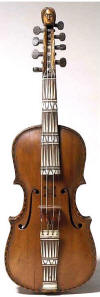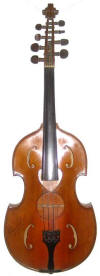|
Hardanger fiddles or Hardingfele is a traditional stringed instrument used originally
to play the music of Norway. Usually with 8 or nine strings, the
extra underneath the fingerboard known as sympathetic string
which resonate with the playing of the top melody four giving a
reverberating echo like sound.
The traditional form of the Hardanger
with much decoration dates from about 1850, but
earlier forms from the 17th century.
The fingerboard decorated with bone and horn inlay as is the
tail piece. The body with much intricate pen-work. The body is
standard violin shape but with a flat high table and high cut f
holes. The wood on many traditional fiddles is much thinner, and
the necks shorter, baroque style and with a carved troll/lion
finial gold painted crown. They will not generally take the
strain of standard violin strings and tuning(some more modern
instruments will) but have there own
style, tuned to A D A E commonly the under-strings tuned B D E F#
A. There are 20 different tuning variations depending on the
region. There is one called Troll tuning A E A C# used for the
strange fanitullen tunes also called devils tunes. There are
regional variations of the Hardanger such as the
plainer
Setesdalsfele fiddle (A standard
violin body) a more modern development. |








